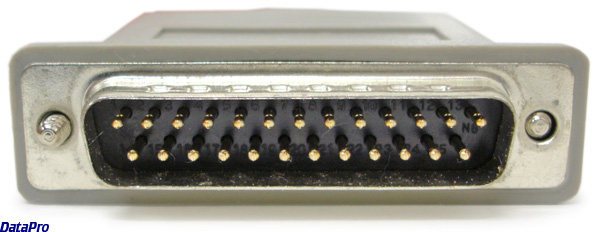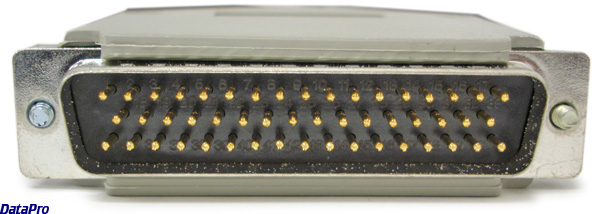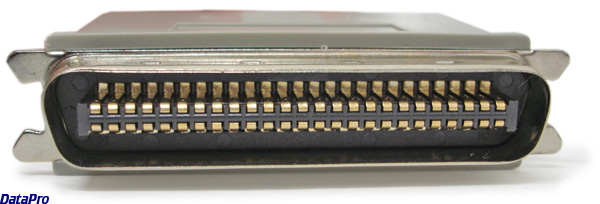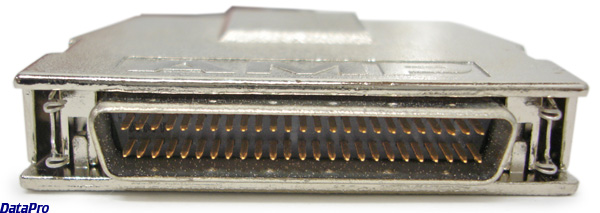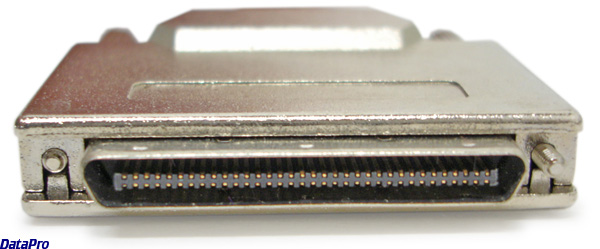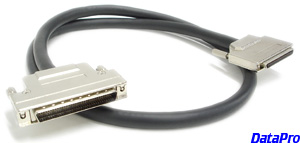
- What is SCSI ?
- SCSI I, II, II, and LVD
- SCSI Connectors
- SCSI Termination
- Single-Ended vs. Differential
- SCSI Devices that do not work together
- List of DataPro SCSI Products
WHAT IS SCSI ?
SCSI stands for (S)mall (C)omputer (S)ystems (I)nterface. The official name of the SCSI standard is: ANSI X3.131 - 1986.The SCSI interface is a local bus type interface for connecting multiple devices (up to eight), designated as either initiators (drivers) or targets (receivers).
There are two electrical alternatives for this standard:
Single-ended and Differential devices are different and MAY NOT be mixed on the same bus; however, LVD (or 'Low Voltage Differential') SCSI can be used on the same SCSI bus with 'SE' type devices, if:
- Single-ended type and
- Differential type
- Your SCSI card supports this; and
- You are using a multi-mode type terminator, sometimes designated as 'LVD/SE' type.
In a SCSI environment, devices are daisy - chained together using a common cable. Both ends of the cable must be terminated. All signals are common between all SCSI devices.
SCSI I, II, III, and LVD
SCSI-1
SCSI-1, the first SCSI Standard, was approved in 1986 and supports transfer rates of up to 5 Mbps. In contrast to other interconnects at the time, SCSI was popularized by supporting multiple devices over a single chain—up to 7 devices on an 8-bit bus (not including the controller card).The most common type of connector for SCSI-1 is the Centronics 50, also called Telco 50 or Amphenol 50 (for external use). This large, rounded connector is similar to the 25-pin Centronics found on old parallel printers, but of course much larger. Internally, SCSI-1 is always run on Dual-Row Socket (F) connectors with 50 conductor ribbon cable.
SCSI-2
SCSI-2, also called "Wide SCSI", first appeared in 1994 and supported 16-bit and 32-bit buses. The transfer rate of 10 Mbps was an incremental bump from SCSI-1, and could be pushed up to 40 Mbps in the right conditions. In external connections, SCSI-2 usually uses a Micro-D 50 pin connector with side clips, also known as the Mini-50, Micro-50, and Micro DB50. Internally, SCSI-2 is run on the same 50-pin two-row ribbon cables as SCSI-1.SCSI-3
Found mainly in high-end systems, SCSI-3 commonly uses a 68-pin ribbon cable for in-cabinet connections, and a 68-pin shielded twisted-pair for external connections. Unlike SCSI-1 and SCSI-2, the internal and external 68-pin connectors can be interconnected. The most common bus width for SCSI-3 is 16-bit with transfer rates of 20 Mbps.LVD SCSI
The last of the great SCSI connectors is LVD SCSI, which boasts transfer rates up to 160 MB/sec under optimal conditions (good quality SCSI card, LVD-compliant cabling, and proper termination). The higher-bandwidth of LVD SCSI requires more precise wiring, particularly the use of twisted-pair wire to support the full speed of the LVD signal.
SCSI Connectors
DB25 - 25 Pin D-Sub
One of the oldest SCSI connectors, the 25-pin DSub connector is the same plug as found on many parallel ports, but SCSI is not interchangeable. It features two rows of low-density pins and thumbscrews.
DB50 - 50 Pin D-Sub
The 50-pin DSub SCSI connector features three rows of low-density pins and thumbscrews. Because of the bulkiness and width of this connector, it is fairly uncommon.
CN50 - 50 pin Centronics
A common SCSI connector on devices is the Centronics 50-pin connector, which features a slot of contacts and wire securing snaps. It is of similar construction to the 36-pin Centronics connector found on parallel printers, but is much wider to accommodate 50 pins. This connector is commonly referred to as SCSI-1.
DH50 - 50 Pin High-Density
Also known as SCSI-2, this connector features two rows of high-density pins with clamping braces. This higher density connector provides the bandwidth of the previous models in much less space.
HS50 - 50 Pin Ribbon
This is the internal companion to the above 50-pin connector sets. The HS50 connector is a crimping connector to mount on ribbon cables, and is almost exclusively used on internal components such as hard drives and optical media drives.
DH68 - 68 Pin High Density
The most common SCSI interface is the 68-pin high-density connector, which features two rows of high-density pins. This connector is known as SCSI-3 and is found on both internal and external components. This connector can also be used for Low-Voltage Differential (LVD) buses.
VHDCI / UHD - 68 pin Ultra-High Density
The Ultra-High Density SCSI connector is an extremely compact 68-pin connector with a slot of contacts and securing screws. This connector is also compatible with LVD buses, and can also be referred to as SCSI-4.
SCSI TERMINATION
Single Ended:Allows up to 5 mb per sec. data transfer rate.Passive:220/330 Ohms For lower data transfer ratesActive:Termination of each signal consists of 220 Ohms to Term Power Line and 330 Ohms to ground.
36 resistors. Ideal Impedance match is 132 ohms.
Passive termination is the oldest method of termination. A passive terminator (actually, terminating resistor) sits on the bus to minimize reflections at the end of the cable.
Passive terminators simply provide impedance close to the impedance of the cable. The terminator is passive since it doesn't do any work to regulate power for termination; it relies on the interface card to provide steady power.
Also referred to as "regulated" or "Boulay".Differential:This is a more stable form of terminating SCSI cables.
Active terminators control the impedance at the end of the SCSI bus by using a voltage regulator, not just the power supplied by the SCSI card.
This type of termination supports longer cable lengths and faster data transfer rates than does passive termination.
There are 18 110-Ohm resistors, three or more capacitors, two voltage reference resistors, and one voltage regulator.
Allows up to 10 MB per sec., and cable lengths up to 25 meters (about 82.5 feet).Forced-Perfect Termination:Requires more powerful drivers than single-ended SCSI. Ideal impedance match is 122 Ohms.
Of all SCSI terminators, this is the most complex and also the most efficient. A cable with a Forced-Perfect terminator can actually change is impedance to compensate for variations along the bus. Forced-Perfect terminators force the impedance of the cable to match each device through diode switching and biasing.
SINGLE - ENDED vs. DIFFERENTIAL
The set of signals for Single - Ended devices is very different from the signals for Differential devices. For Differential devices all signals consist of two lines denoted +SIGNAL and - SIGNAL, while for Single - Ended devices all signals consist of one line (SIGNAL).Single - Ended (SE) and Differential devices CAN NOT be mixed on the same SCSI cable - except for LVD/SE, mentioned above. The designation 'Differential' generally refers to High-Voltage differential, which is mainly used on older, larger systems such as IBM mainframes. This type of SCSI is not common with personal computers.
SINGLE - ENDED CABLES:
Single - Ended cables connect up to eight drivers and receivers.
A 50 conductor flat cable or 25 signal twisted-pair cable should be used. The maximum cable length shall be 6 meters (primarily for connection within a cabinet). A stub length of no more than 0.1 meters is allowed.
DIFFERENTIAL CABLES:
Differential cables connect up to eight Differential drivers and receivers. A 50 - conductor cable or 25 - signal twisted - pair cable shall be used. The maximum cable length shall be 25 meters (primarily for connection outside of a cabinet).
A stub length of no more than 0.2 meters is allowed.
LOW-VOLTAGE (LVD) DIFFERENTIAL CABLES:
LVD SCSI cables are similar to high-end SE cables, however they must meet more stringent requirements than SE cables. An internal LVD ribbon cable will be a twisted-pair type cable, rather than the flat ribbon cable that is used for SE type SCSI. If you want to combine SE and LVD devices on one SCSI cable, you must use the higher-quality LVD cable in order for the LVD devices to work.
IMPEDANCE REQUIREMENTS
IDEAL characteristic impedance:
However, cables with such high characteristic impedance are not usually available. As a result, the SCSI standard requires the following:
- Single-Ended cables: 132 ohms
- Differential cables: 122 ohms
A somewhat lower characteristic impedance is acceptable since few cable types meet the above requirements. Trade - offs in shielding effectiveness, characteristic impedance, cable length, number of loads, transfer rates, and cost, can be made to some limited degree. NOTE: To minimize discontinuities and signal reflections, cables of different impedances should not be used in the same bus.
- For unshielded flat or twisted - pair cables: 100 ohms +/ - 10%
- For shielded cables: 90 ohms or greater
SCSI DEVICES THAT DO NOT WORK TOGETHER
The SCSI standard contains various alternatives which are mutually exclusive within a system (or a bus).These mutually exclusive alternatives are:
This means that the two devices you connect with a SCSI cable must be compatible, or of the same type, in terms of each of the five features listed above. For instance, both devices should be differential or both should be single - ended; At the same time, both should have a "hard" RESET or a "soft" RESET and so on...for each of the five features above.
- Single - ended or differential
- Termination power supplied by the cable or not
- Parity implemented or not
- "Hard" RESET or "Soft" RESET
- Reservation queuing implemented or not
You can find out what features your SCSI devices have by reading the STATEMENT OF CONFORMANCE with the standard in the device documentation.
For more information about SCSI, look at Gary Field's treatise.
Written by DataPro International Inc.
Unauthorized duplication strictly prohibited.






